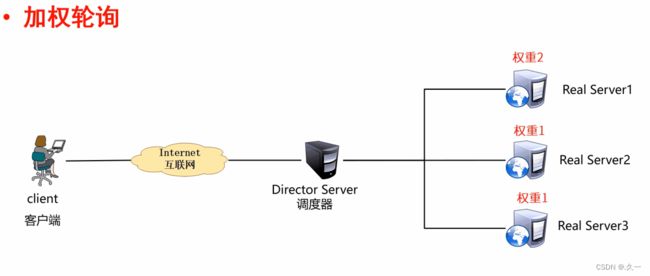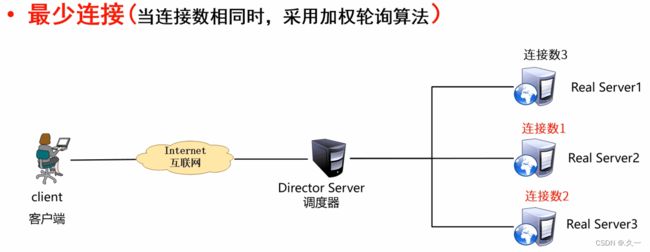Nginx 学习(九)集群概述与LVS工作模式的配置
一 集群
1 概述
- 通过高速网络将很多服务器集中起来一起提供同一种服务,在客户端看来就像是只有一个服务器
- 可以在付出较低成本的情况下获得在性能、可靠性、灵活性方面的相对较高的收益
- 任务调度是集群系统中的核心技术
2 目的
- 提高性能。如计算密集型应用,如:天气预报、核试验模拟
- 降低成本。相对百万美元级的超级计算机,价格便宜
- 提高可扩展性。只要增加集群节点即可
- 增强可靠性。多个节点完成相同功能,避免单点失败
3 分类
高性能计算集群HP。通过以集群开发的并行应用程序,解决复杂的科学问题
负载均衡(LB)集群。客户端负载在计算机集群中尽可能平均分摊。
高可用(HA)集群。避免单点故障,当一个系统发生故障时,可以快速迁移。
二 LVS
1 概述
- Linux虚拟服务器 (LVS) 是章文嵩在国防科技大学就读博士期间创建的
- LVS可以实现高可用的、可伸缩的Web、Mail、Cache和Media等网络服务
- 最终目标是利用Linux操作系统和LVS集群软件实现一个高可用、高性能、低成本的服务器应用集群
2 组成
前端:负载均衡层。由一台或多台负载调度器构成
中间:服务器群组层。由一组实际运行应用服务的服务器组成
底端:数据共享存储层。提供共享存储空间的存储区域
3 术语
Director Server: 调度服务器,将负载分发到Real Server的服务器
Real Server:真实服务器-真正提供应用服务的服务器
VIP:虚拟IP地址-公布给用户访问的虚拟IP地址
DIP:调度器连接后端节点服务器的IP地址
RIP:真实IP地址。集群节点上使用的IP地址
4 工作模式
VS/NAT(网络地址转换)
- 通过网络地址转换实现的虚拟服务器
- 大并发访问时,调度器的性能成为瓶颈
VS/DR(路由模式)
- 直接使用路由技术实现虚拟服务器
- 节点服务器需要配置VIP,注意MAC地址广播
VS/TUN(隧道模式)
- 通过隧道方式实现虚拟服务器
5 负载均衡调度算法
LVS目前实现了10种调度算法
常见的调度算法
- 轮询rr:Real Server轮流提供服务
- 加权轮询wrr:根据服务器性能设置权重,权重大的得到的请求更多
- 最少连接lc:根据Real Server的连接数分配请求
- 加权最少连接wlc:类似于wrr,根据权重分配请求
三 配置
1 LVS NAT模式
- 架构图
-
环境准备
| client1 | eth0->192.168.88.10 | 网关192.168.88.5 |
| lvs1 | eth0 -> 192.168.88.5 eth1 -> 192.168.99.5 |
|
| web1 | eth1->192.168.99.100 | 网关192.168.99.5 |
| web2 | eth1->192.168.99.200 | 网关192.168.99.5 |
# 创建4台虚拟机
[root@myhost ~]# vm clone client1 lvs1 web{1..2}
# 初始化虚拟机
[root@myhost ~]# virsh console client1 # 连接client1控制台
localhost login: root
Password: a
# 登陆之后,将以下内容粘贴到终端
hostnamectl set-hostname client1
nmcli connection modify "System eth0" con-name eth0
nmcli connection modify eth0 ipv4.method manual ipv4.addresses 192.168.88.10/24 autoconnect yes ipv4.gateway 192.168.88.5
nmcli connection down eth0
nmcli connection up eth0
# 退出
[root@localhost ~]# exit
# 退出之后,按ctrl+]可回到真机
# 真机通过ssh连接client1
[root@myhost ~]# rm -f ~/.ssh/known_hosts
[root@myhost ~]# ssh 192.168.88.10
# 配置第2台机器作为lvs1
[root@myhost ~]# virsh console lvs1
localhost login: root
Password: a
# 登陆之后,将以下内容复制到命令行
hostnamectl set-hostname lvs1
nmcli connection modify "System eth0" con-name eth0
nmcli connection modify eth0 ipv4.method manual ipv4.addresses 192.168.88.5/24 autoconnect yes
nmcli connection down eth0
nmcli connection up eth0
rm -f /etc/sysconfig/network-scripts/ifcfg-eth1
nmcli connection add con-name eth1 ifname eth1 type ethernet autoconnect yes ipv4.method manual ipv4.addresses 192.168.99.5/24
reboot # 重启系统,使得eth1网卡生效
# 按ctrl+]可回到真机
# 真机通过ssh连接lvs1
[root@myhost ~]# ssh 192.168.88.5
# 配置第3台机器作为web1
[root@myhost ~]# virsh console web1
localhost login: root
Password: a
# 登陆之后,将以下内容复制到命令行
hostnamectl set-hostname web1
nmcli connection modify "System eth0" con-name eth0
nmcli connection modify eth0 autoconnect no
rm -f /etc/sysconfig/network-scripts/ifcfg-eth1
nmcli connection add con-name eth1 ifname eth1 type ethernet autoconnect yes ipv4.method manual ipv4.addresses 192.168.99.100/24 ipv4.gateway 192.168.99.5
reboot
# 按ctrl+]可回到真机
# 真机通过ssh连接web1
[root@myhost ~]# ssh 192.168.99.100
# 配置第4台机器作为web2
[root@myhost ~]# virsh console web2
localhost login: root
Password: a
# 登陆之后,将以下内容复制到命令行
hostnamectl set-hostname web2
nmcli connection modify "System eth0" con-name eth0
nmcli connection modify eth0 autoconnect no
rm -f /etc/sysconfig/network-scripts/ifcfg-eth1
nmcli connection add con-name eth1 ifname eth1 type ethernet autoconnect yes ipv4.method manual ipv4.addresses 192.168.99.200/24 ipv4.gateway 192.168.99.5
reboot
# 按ctrl+]可回到真机
# 真机通过ssh连接web2
[root@myhost ~]# ssh 192.168.99.200- 虚拟机已关闭selinux和防火墙 。
- 在pubserver上准备管理环境
# 创建工作目录
[root@pubserver ~]# mkdir cluster
[root@pubserver ~]# cd cluster/
#创建主配置文件
[root@pubserver cluster]# vim ansible.cfg
[defaults]
inventory = inventory
host_key_checking = false # 不检查主机密钥
# 创建主机清单文件及相关变量
[root@pubserver cluster]# vim inventory
[clients]
client1 ansible_host=192.168.88.10
[webservers]
web1 ansible_host=192.168.99.100
web2 ansible_host=192.168.99.200
[lb]
lvs1 ansible_host=192.168.88.5
[all:vars] # all是ansible自带的组,表示全部主机
ansible_ssh_user=root
ansible_ssh_pass=a
# 创建文件目录,用于保存将要拷贝到远程主机的文件
[root@pubserver cluster]# mkdir files
# 编写yum配置文件
[root@pubserver cluster]# vim files/local88.repo
[BaseOS]
name = BaseOS
baseurl = ftp://192.168.88.240/dvd/BaseOS
enabled = 1
gpgcheck = 0
[AppStream]
name = AppStream
baseurl = ftp://192.168.88.240/dvd/AppStream
enabled = 1
gpgcheck = 0
[rpms]
name = rpms
baseurl = ftp://192.168.88.240/rpms
enabled = 1
gpgcheck = 0
[root@pubserver cluster]# vim files/local99.repo
[BaseOS]
name = BaseOS
baseurl = ftp://192.168.99.240/dvd/BaseOS
enabled = 1
gpgcheck = 0
[AppStream]
name = AppStream
baseurl = ftp://192.168.99.240/dvd/AppStream
enabled = 1
gpgcheck = 0
[rpms]
name = rpms
baseurl = ftp://192.168.99.240/rpms
enabled = 1
gpgcheck = 0
# 编写用于上传yum配置文件的playbook
[root@pubserver cluster]# vim 01-upload-repo.yml
---
- name: config repos.d
hosts: all
tasks:
- name: delete repos.d # 删除repos.d目录
file:
path: /etc/yum.repos.d
state: absent
- name: create repos.d # 创建repos.d目录
file:
path: /etc/yum.repos.d
state: directory
mode: '0755'
- name: config local88 # 上传repo文件到88网段
hosts: clients,lb
tasks:
- name: upload local88
copy:
src: files/local88.repo
dest: /etc/yum.repos.d/
- name: config local99 # 上传repo文件到99网段
hosts: webservers
tasks:
- name: upload local99
copy:
src: files/local99.repo
dest: /etc/yum.repos.d/
[root@pubserver cluster]# ansible-playbook 01-upload-repo.yml2 配置LVS NAT模式步骤
<1> 操作流程
Real Server:
- 配置WEB服务器
Director Server:
- 在上安装并启用ipvsadm- 创建虚拟服务器
- 向虚拟服务器中加入节点
Client:
- 连接虚拟服务器测试
<2> 实施
- 配置2台web服务器
# 创建首页文件,文件中包含ansible facts变量
[root@pubserver cluster]# vim files/index.html
Welcome from {{ansible_hostname}}
# 配置web服务器
[root@pubserver cluster]# vim 02-config-webservers.yml
---
- name: config webservers
hosts: webservers
tasks:
- name: install nginx # 安装nginx
yum:
name: nginx
state: present
- name: upload index # 上传首页文件到web服务器
template:
src: files/index.html
dest: /usr/share/nginx/html/index.html
- name: start nginx # 启动服务
service:
name: nginx
state: started
enabled: yes
[root@pubserver cluster]# ansible-playbook 02-config-webservers.yml
# 在lvs1上测试到web服务器的访问
[root@lvs1 ~]# curl http://192.168.99.100
Welcome from web1
[root@lvs1 ~]# curl http://192.168.99.200
Welcome from web2- 确保lvs1的ip转发功能已经打开。该功能需要改变内核参数
# 查看ip转发功能的内核参数
[root@lvs1 ~]# sysctl -a # 查看所有的内核参数
[root@lvs1 ~]# sysctl -a | grep ip_forward # 查看ip_foward参数
net.ipv4.ip_forward = 1 # 1表示打开转发,0表示关闭转发
# 设置打开ip_forward功能
[root@pubserver cluster]# vim 03-sysctl.yml
---
- name: config sysctl
hosts: lb
tasks:
- name: set ip_forward
sysctl: # 用于修改内核参数的模块
name: net.ipv4.ip_forward # 内核模块名
value: '1' # 内核模块的值
sysctl_set: yes # 立即设置生效
sysctl_file: /etc/sysctl.conf # 配置写入文件
[root@pubserver cluster]# ansible-playbook 03-sysctl.yml
# 测试从客户端到服务器的访问
[root@client1 ~]# curl http://192.168.99.100
Welcome from web1
[root@client1 ~]# curl http://192.168.99.200
Welcome from web2- 安装LVS
[root@pubserver cluster]# vim 04-inst-lvs.yml
---
- name: install lvs
hosts: lb
tasks:
- name: install lvs # 安装lvs
yum:
name: ipvsadm
state: present
[root@pubserver cluster]# ansible-playbook 04-inst-lvs.ymlipvsadm使用说明
-A: 添加虚拟服务器
-E: 编辑虚拟服务器
-D: 删除虚拟服务器
-t: 添加tcp服务器
-u: 添加udp服务器
-s: 指定调度算法。如轮询rr/加权轮询wrr/最少连接lc/加权最少连接wlc
-a: 添加虚拟服务器后,向虚拟服务器中加入真实服务器
-r: 指定真实服务器
-w: 设置权重
-m: 指定工作模式为NAT
-g: 指定工作模式为DRipvsadm命令用法
- 使用命令添加基于TCP一些的集群服务
- 在集群中添加若千台后端真实服务器
- 实现同一客户端访问,调度器分配固定服务器
- 会使用ipvsadm实现规则的增、删、改保存ipvsadm规则
- 配置LVS
# 为web服务器创建虚拟服务器,使用rr调度算法
[root@lvs1 ~]# ipvsadm -A -t 192.168.88.5:80 -s rr
# 查看配置
[root@lvs1 ~]# ipvsadm -Ln # L是列出,n是使用数字,而不是名字
# 向虚拟服务器中添加RIP
[root@lvs1 ~]# ipvsadm -a -t 192.168.88.5:80 -r 192.168.99.100 -w 1 -m
[root@lvs1 ~]# ipvsadm -a -t 192.168.88.5:80 -r 192.168.99.200 -w 2 -m
# 查看配置
[root@lvs1 ~]# ipvsadm -Ln
# 验证
[root@client1 ~]# for i in {1..6}
> do
> curl http://192.168.88.5
> done
Welcome from web2
Welcome from web1
Welcome from web2
Welcome from web1
Welcome from web2
Welcome from web1
# 删除配置。(如果配置有错,用以下命令删除重配置)
[root@lvs1 ~]# ipvsadm -D -t 192.168.88.5:80
# 修改调度模式为加权轮询
[root@lvs1 ~]# ipvsadm -E -t 192.168.88.5:80 -s wrr
# 验证配置
[root@client1 ~]# for i in {1..6}; do curl http://192.168.88.5; done
Welcome from web2
Welcome from web2
Welcome from web1
Welcome from web2
Welcome from web2
Welcome from web13 LVS DR模式
- 架构图
-
LVS DR模式,LVS主机和web服务器都是单网卡。它们连在同一网络中
-
修改实验环境
| client1 | eth0-> 192.168.88.10 | |
| lvs1 | eth0->192.168.88.5 | 删除eth1的IP |
| web1 | eth0->192.168.88.100 | 删除eth1的IP |
| web2 | eth0->192.168.88.200 | 删除eth1的IP |
# 删除lvs虚拟服务器配置
[root@lvs1 ~]# ipvsadm -D -t 192.168.88.5:80
[root@lvs1 ~]# ipvsadm -Ln
# 删除lvs1上eth1的配置
[root@lvs1 ~]# nmcli connection modify eth1 ipv4.method disabled ipv4.addresses ''
[root@lvs1 ~]# nmcli connection down eth1
# 修改web1的配置:停掉eth1的地址。配置eth0的地址为192.168.88.100
# 进入网卡配置文件目录
[root@web1 ~]# cd /etc/sysconfig/network-scripts/
# eth0网卡的配置文件叫ifcfg-eth0
[root@web1 network-scripts]# ls ifcfg-eth*
ifcfg-eth0 ifcfg-eth1
# 配置eth0地址
[root@web1 network-scripts]# vim ifcfg-eth0
TYPE=Ethernet # 网络类型为以太网
BOOTPROTO=none # IP地址是静态配置的,也可以用static
NAME=eth0 # 为设备重命名
DEVICE=eth0 # 网卡设备名
ONBOOT=yes # 开机激活网卡
IPADDR=192.168.88.100 # IP地址
PREFIX=24 # 子网掩码长度
GATEWAY=192.168.88.254 # 网关
[root@web1 ~]# systemctl restart NetworkManager # 重启网络服务
# 在web1上停掉eth1
[root@web1 ~]# vim /etc/sysconfig/network-scripts/ifcfg-eth1
TYPE=Ethernet
BOOTPROTO=none
NAME=eth1
DEVICE=eth1
ONBOOT=no
[root@web1 ~]# nmcli connection down eth1 # 终端卡住,关掉它,在新终端重新连
# 修改web2的网络
[root@web2 ~]# vim /etc/sysconfig/network-scripts/ifcfg-eth0
TYPE=Ethernet
BOOTPROTO=none
NAME=eth0
DEVICE=eth0
ONBOOT=yes
IPADDR=192.168.88.200
PREFIX=24
GATEWAY=192.168.88.254
[root@web2 ~]# systemctl restart NetworkManager
[root@web2 ~]# vim /etc/sysconfig/network-scripts/ifcfg-eth1
TYPE=Ethernet
BOOTPROTO=none
NAME=eth1
DEVICE=eth1
ONBOOT=no
[root@web2 ~]# nmcli connection down eth1
# 修改pubserver的主机清单文件
[root@pubserver cluster]# cp inventory inventory.bak
[root@pubserver cluster]# vim inventory
[clients]
client1 ansible_host=192.168.88.10
[webservers]
web1 ansible_host=192.168.88.100
web2 ansible_host=192.168.88.200
[lb]
lvs1 ansible_host=192.168.88.5
[all:vars]
ansible_ssh_user=root
ansible_ssh_pass=a
# 修改2台web服务器yum配置文件中的地址
[root@web1 ~]# sed -i 's/99/88/' /etc/yum.repos.d/local99.repo
[root@web1 ~]# cat /etc/yum.repos.d/local99.repo
[BaseOS]
name = BaseOS
baseurl = ftp://192.168.88.240/dvd/BaseOS
enabled = 1
gpgcheck = 0
[AppStream]
name = AppStream
baseurl = ftp://192.168.88.240/dvd/AppStream
enabled = 1
gpgcheck = 0
[rpms]
name = rpms
baseurl = ftp://192.168.88.240/rpms
enabled = 1
gpgcheck = 04 配置LVS DR模式
<1>操作流程
Real Server
- 配置WEB服务器
- 配置辅助IP地址、调整内核参数
Director Server
- 在上安装并启用ipvsadml
- 配置辅助IP地址
- 创建虚拟服务器、向虚拟服务器中加入节点
Client:
- 连接虚拟服务器测试
<2> ARP广播的问题
当客户端发起访问VIP对应的域名的请求时,根据网络通信原理会产生ARP广播
因为负载均衡器和真实的服务器在同一网络并且VIP设置在集群中的每个节点上
此时集群内的真实服务器会尝试回答来自客户端的ARP广播,这就会产生问题,大家都说我是VIP
<3> 内核参数说明
arp_ignore(定义回复ARP广播的方式)
-0:回应所有的本地地址ARP广播,本地地址可以配置在任意网络接口(默认值)
-1:只回应配置在入站网卡接口上的任意IP地址的ARP广播
arp_announce
-0:使用配置在任意网卡接口上的本地IP地址
-2:对查询目标使用最适当的本地地址。在此模式下将忽略这个IP数据包的源地址并尝试选择与能与该地址通信的本地地址。首要是选择所有的网络接口的子网中外出访问子网中包含该目标IP地址的本地地址。如果没有合适的地址被发现,将选择当前的发送网络接口或其他的有可能接受到该ARP回应的网络接口来进行发送
<4> 实施
- 在lvs1的eth0上配置vip 192.168.88.15。
[root@pubserver cluster]# vim 05-config-lvsvip.yml
---
- name: config lvs vip
hosts: lb
tasks:
- name: add vip
lineinfile: # 确保文件中有某一行内容
path: /etc/sysconfig/network-scripts/ifcfg-eth0
line: IPADDR2=192.168.88.15
notify: restart eth0 # 通知执行handlers中的任务
handlers: # 被通知执行的任务写到这里
- name: restart eth0
shell: nmcli connection down eth0; nmcli connection up eth0
[root@pubserver cluster]# ansible-playbook 05-config-lvsvip.yml
# 在lvs1查看添加的IP地址
[root@lvs1 ~]# ip a s eth0 | grep 88
inet 192.168.88.5/24 brd 192.168.88.255 scope global noprefixroute eth0
inet 192.168.88.15/24 brd 192.168.88.255 scope global secondary noprefixroute eth0- 在2台web服务器的lo上配置vip 192.168.88.15。
lo:0网卡需要使用network-scripts提供的配置文件进行配置。
[root@pubserver cluster]# vim 06-config-webvip.yml
---
- name: config webservers vip
hosts: webservers
tasks:
- name: install network-scripts # 安装服务
yum:
name: network-scripts
state: present
- name: add lo:0 # 创建lo:0的配置文件
copy:
dest: /etc/sysconfig/network-scripts/ifcfg-lo:0
content: |
DEVICE=lo:0
NAME=lo:0
IPADDR=192.168.88.15
NETMASK=255.255.255.255
NETWORK=192.168.88.15
BROADCAST=192.168.88.15
ONBOOT=yes
notify: activate lo:0
handlers:
- name: activate lo:0 # 激活网卡
shell: ifup lo:0
[root@pubserver cluster]# ansible-playbook 06-config-webvip.yml
# 查看结果
[root@web1 ~]# cd /etc/sysconfig/network-scripts/
[root@web1 network-scripts]# cat ifcfg-lo:0
DEVICE=lo:0
NAME=lo:0
IPADDR=192.168.88.15
NETMASK=255.255.255.255
NETWORK=192.168.88.15
BROADCAST=192.168.88.15
ONBOOT=yes
[root@web1 network-scripts]# ifconfig # 可以查看到lo:0网卡信息
lo:0: flags=73 mtu 65536
inet 192.168.88.15 netmask 255.255.255.255
loop txqueuelen 1000 (Local Loopback) - 在2台web服务器上配置内核参数,使得它们不响应对192.168.88.15的请求
[root@web1 ~]# sysctl -a | grep arp_ignore
net.ipv4.conf.all.arp_ignore = 1
net.ipv4.conf.lo.arp_ignore = 0
[root@web1 ~]# sysctl -a | grep arp_announce
net.ipv4.conf.all.arp_announce = 2
net.ipv4.conf.lo.arp_announce = 0
[root@web1 ~]# vim /etc/sysctl.conf
net.ipv4.conf.all.arp_ignore = 1
net.ipv4.conf.lo.arp_ignore = 1
net.ipv4.conf.all.arp_announce = 2
net.ipv4.conf.lo.arp_announce = 2
[root@web1 ~]# sysctl -p
[root@web2 ~]# vim /etc/sysctl.conf
net.ipv4.conf.all.arp_ignore = 1
net.ipv4.conf.lo.arp_ignore = 1
net.ipv4.conf.all.arp_announce = 2
net.ipv4.conf.lo.arp_announce = 2
[root@web2 ~]# sysctl -p- 在lvs1上配置虚拟服务器
# 创建虚拟服务器
[root@lvs1 ~]# ipvsadm -A -t 192.168.88.15:80 -s wlc
# 向虚拟服务器中加真实服务器
[root@lvs1 ~]# ipvsadm -a -t 192.168.88.15:80 -r 192.168.88.100 -w 1 -g
[root@lvs1 ~]# ipvsadm -a -t 192.168.88.15:80 -r 192.168.88.200 -w 2 -g
# 查看配置
[root@lvs1 ~]# ipvsadm -Ln
# 客户验证
[root@client1 ~]# for i in {1..6}; do curl http://192.168.88.15/; done
Welcome from web2
Welcome from web1
Welcome from web2
Welcome from web2
Welcome from web1
Welcome from web2附:出错时,排错步骤:
# 在lvs上可以访问到web服务器
[root@lvs1 ~]# curl http://192.168.88.100/
192.168.99.100
[root@lvs1 ~]# curl http://192.168.88.200/
apache web server2
# 查看vip
[root@lvs1 ~]# ip a s eth0 | grep 88
inet 192.168.88.5/24 brd 192.168.88.255 scope global noprefixroute eth0
inet 192.168.88.15/24 brd 192.168.88.255 scope global secondary noprefixroute eth0
[root@web1 ~]# ifconfig lo:0
lo:0: flags=73 mtu 65536
inet 192.168.88.15 netmask 255.255.255.255
loop txqueuelen 1000 (Local Loopback)
# 查看内核参数
[root@web1 ~]# sysctl -p
net.ipv4.conf.all.arp_ignore = 1
net.ipv4.conf.lo.arp_ignore = 1
net.ipv4.conf.all.arp_announce = 2
net.ipv4.conf.lo.arp_announce = 2
# 查看规则
[root@lvs1 ~]# ipvsadm -Ln
IP Virtual Server version 1.2.1 (size=4096)
Prot LocalAddress:Port Scheduler Flags
-> RemoteAddress:Port Forward Weight ActiveConn InActConn
TCP 192.168.88.15:80 wlc
-> 192.168.88.100:80 Route 1 0 12
-> 192.168.88.200:80 Route 2 0 18 




